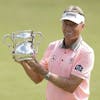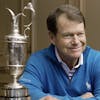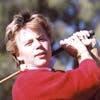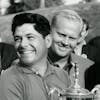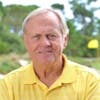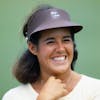Pat Bradley - Part 3 (Winning Four More Majors)
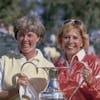
In this enthralling third episode of our four-part series with World Golf Hall of Fame member Pat Bradley, we focus on her remarkable 1986 season, a year that cemented her legacy in the annals of golf history. This segment offers a deep dive into the highs and lows of a year that was nearly unparalleled in the sport.
Pat shares her experiences from the 1986 Women’s U.S. Open, where she narrowly missed joining a playoff, finishing T-5. This moment of near triumph sets the stage for an exploration of a year filled with dramatic victories and intense personal challenges.
The episode shines as Pat recounts her victories at the three other major championships: the Dinah Shore, the LPGA Championship and the du Murier Classic. Her detailed narration of these tournaments, coupled with the strategic thought processes and mental fortitude that led to these wins, provides listeners with a rare glimpse into the mind of a golfing great.
A central theme of the episode is Pat's almost historic accomplishment of winning all four majors in a single year, a feat that eluded her by the narrowest of margins. This journey through her 1986 season is a testament to her exceptional skill and the relentless determination that drove her career.
Pat also opens up about her personal struggles, including her battle with Graves' disease, which she faced in the aftermath of her extraordinary season. This honest account adds a poignant layer to the narrative, highlighting the resilience required to overcome such formidable obstacles.
Listeners are treated to not just a recount of Pat Bradley’s professional triumphs, but a heartfelt story of perseverance and the relentless pursuit of excellence. This episode is a compelling tribute to a year that defined Pat Bradley as one of the greatest golfers of her time, making it an essential listen for fans of the sport and admirers of extraordinary life stories alike.
Follow our show and/or leave a review/rating on:
Our Website https://www.forethegoodofthegame.com/reviews/new/
Apple Podcasts https://podcasts.apple.com/us/podcast/fore-the-good-of-the-game/id1562581853
Spotify Podcasts https://open.spotify.com/show/0XSuVGjwQg6bm78COkIhZO?si=b4c9d47ea8b24b2d
Google Podcasts https://podcasts.google.com/feed/aHR0cHM6Ly9mZWVkcy5idXp6c3Byb3V0LmNvbS8xNzM3Mjc1LnJzcw
About
"FORE the Good of the Game” is a golf podcast featuring interviews with World Golf Hall of Fame members, winners of major championships and other people of influence in and around the game of golf. Highlighting the positive aspects of the game, we aim to create and provide an engaging and timeless repository of content that listeners can enjoy now and forever. Co-hosted by PGA Tour star Bruce Devlin, our podcast focuses on telling their life stories, in their voices. Join Bruce and Mike Gonzalez “FORE the Good of the Game.”
Thanks so much for listening!
Music playing 00:00
Mike Gonzalez 00:15
Well, let's move on to more happier times I guess because you go into that next year, you win three times, you pick up another major Bruce. Quite a year in 1985 leading up to what is going to be one of her greatest career years ever.
Devlin, Bruce 00:31
Yeah, the Rochester International and then the duMaurier Classic, where you beat James Geddes by a shot and finished off with the LPGA National ProAm where you beat Amy Alcott in a playoff.
Bradley, Pat 00:47
Yes, Bruce. Rochester International at Locust Hills, that was my second win at this Golf Course. And again, Nancy and I had a tremendous rivalry at this event. I'll never forget coming up 18 and, Nancy and I were in the same group. And we're coming up 18th and on one side, you would hear "Come on, Pat. Let's go Pat". And then on the other side, you'd hear "come on Nancy", it was going back and forth, all the way from the tee to the green. There were people chanting our names, and it was an amazing atmosphere. It was like a stadium. And fortunately, on that day of 1985, I ended up winning the event, but it was always a pleasure to play in front of those Rochester, New York people. They loved golf. And of course, they loved Nancy, myself, Patty Sheehan had great success in Rochester too. So that was that was a great win there. And then, of course, I went to the du Maurier, which is now du Maurier and not the Peter Jackson, and Beaconsfield, another great Golf Course. It tested allof your strengths. And I remember on 18, I made a 20 foot downhill putt that went in the hole on 18 to beat Jane Geddes. And it was another great moment. When you have those types of finishes where you need this putt in order to win, and it happened. It happened at the du Maurier there and it just added to my majors.
Devlin, Bruce 03:05
Another great weekend too I might add shooting 67, 68 at the weekend 135. That's a pretty salty finish.
Bradley, Pat 03:14
Yep. And then there's an interesting here at the National Program at Lone Tree, which was designed by Arnold Palmer, and Meridian, which was designed by Jack Nicklaus. So, you play one day at Lone Tree and another day at Meridian. And then the final was at Meridian. And it was interesting, fellas, because we as a tour did not play too many two Golf Course course set-ups during a tournament. You usually pick the Golf Course and you stay on it for four days. Well, here we went, one day at Lone Tree another day at Meridian. They were across the street, not too bad. But before the tournament even started, people were grumbling in the locker room players. Players were grumbling about, you know, having to deal with two courses. Two different ones. Arnie's different look, Jack's different look, you know, you gotta hit the high fade with Jack and so, I'm in the locker room going. Okay, I can check you off. I can check you off. And lo and behold, by the time Sunday afternoon came it was Amy and I and I was fortunate enough to beat Amy on this second hole, but it was interesting to hear in the locker room, complaints about these two golf courses and I just checked them off. Okay, see ya. Don't have to worry about you. Don't have to worry about you.
Mike Gonzalez 05:16
Mindset is all important going in, isn't it?
Bradley, Pat 05:19
Exactly. Yes.
Devlin, Bruce 05:21
Well, that carried over to for the next year, which I think a lot of people would say was your finest year on the LPGA Tour. Started off and I'm sure it gave you a great thrill to win a Dinah Shore beating Val Skinner by two shots.
Bradley, Pat 05:40
It was that and I have to tell you, fellas, I got to backup just a second. I started in 1985 working with Dr. Bob Rotella. And, I believe Bob helped me to understand myself a little better on the Golf Course. He helped me to embrace and welcome the butterflies that, I might have handled The Dinah Shore in 1984 for a little differently had I worked with Dr. Rotella. I might have. I don't know. But in I started working with Dr. Rotella and he helped me to instead of fearing the butterflies that we get in our game. Lots of times we get them at the beginning of the First Tee. And then as time goes on, they kind of flutter away. And then all of a sudden, for me, they were starting to show up, like around 14, 15, 16. And I was like, what the heck, I got angry. Because I'm like, I thought I was done with you guys. And so, you know, Bob helped me to understand and to embrace it, and to welcome the moment that they show up instead of fearing it. He also might have helped me at the Dinah Shore in 1984. He helped me to be kinder to myself. He helped me to pat myself on the back more. We, as golfers, can be so critical of ourselves in you know, a bad shot or a three putt or whatever. And I mean, I had won 16 times before I started working with Bob Rotella. But I honestly believe that Dr. Bob helped me get over that hump, that next hump that I was struggling with and which helped me to achieve the LPGA Hall of Fame, which I was struggling to meet. I needed 30 wins, I had only 16 And then I started working with Bob, and then I got those other wins pretty quickly. And he was a very important person in my life, in my journey of success on the Golf Course. So, anyways, so that brings me to the 1986 Dinah Shore, which I had been working with Bob and talking with him about, coming back and being able to handle it. And Val I mean, Val's just a great friend. She was a wonderful competitor. And the tough thing that happened to Val is on the first hole, she hit it out of bounds at Mission Hills, and that kind of made it tough for Val that day, but she fought back and I was lucky enough to hold on. And it was wonderful because it meant so much because Dinah was alive. Dinah Shore was alive when I wom. These kids after a certain time, these kids won and they did not know who Dinah Shore was. They did not know the importance of what her giving her name to this event meant and I walked over that bridge, and at the end of the bridge, right by the 18th, green, there was Dinah to you know, have a smile. I mean, I still had my blinders on. I hadn't finished, so I could not relax too much. But she gave me a beautiful smile. And I went on to two putt and, and then I ended up winning and beating Val.
Mike Gonzalez 10:51
So let's go to that second win in 1986, which came at the S&H Golf Classic. I'm sure you got plenty of green stamps for that win.
Bradley, Pat 11:00
I know, how about that guys? They gave us booklets. You know, as our favor gift when we registered and but yes, yes. I remember that the S&H jeez, Pasadena. I don't even know if it's still in existence. It might be all homes now. But yep, I made another, gee whiz, Janet Coles was in the clubhouse. She was on the side of the green. I remember seeing Janet Coles at the side of the green when I was coming up 18 And guys, I made another 20 foot putt to just take it away from Janet. But I remember distinctly you know, usually when you finish, you sign your scorecard, you go to the clubhouse or whatever, but Janet signed her card, but stayed at the green. And I remember seeing her and yet, I made a 20 footer and ended up beating her and that's the week that Kathy went over the million ,Kathy Whitworth became the first woman to go over a million dollars. And Janet Coles wasn't counting on you to finish with a smooth little 65 there either I don't think. No, no, no, no, no, no. Not at all. I just got on a roll, guys. And it was amazing. 1986. I couldn't do anything wrong. Um, you know, guys, I as you say, I had finished close to being number one. And now I've been on tour for 12 years. And I have never been number one. And so I really wanted to have that Player the Year, that Vare Trophy moment, Player the year moment. And 1986 was my three majors, and my other two wins. And so this was fate. This was my moment, to shine, just above anybody else, no matter what anybody did in front of me, I was gonna do just enough to maintain my status to be Player the Year and Vare Trophy winner in 1986. So I had wanted it since I turned pro in 1974. But I was just coming up short. And this was my shining year. Well, we're going to ask you in a minute, after we talk about that final major of the year, we're going to ask you about what it feels like to be in a five-month zone. But before we do, let's go to major number five major number two for the year Bruce, the 1986 LPGA Championship
Devlin, Bruce 14:30
At the Jack Nicklaus Golf Center where you beat another great player Patty Sheehan. Shot 67, 72, 70 and a nice smooth 68 for the last round after coming from four back with 18 holes to play. So pretty good last round there, Pat.
Bradley, Pat 14:49
It was Bruce. I mean, it was it was an interesting Golf Course. You know, a Jack Nicklaus Center. It opened it up for many, many players to be a part of the event. You know, sometimes you go to majors and the setup rules out certain players right away. This tournament, this Golf Course, kept it open to many different players for the whole week. And I remember again, I remember on 18 Patty went for it in two. And she made the green in two. I couldn't. I was in the rough. We had water to go over. So I could not go for it in two. I had to lay up to the right. And Patty was on the green in two and Patty two putted for birdie. Which you know, the crowd went crazy. And then once again, I had another 15-20 footer, downhill that I made on the final hole, to win.
Devlin, Bruce 16:15
You're pretty good with those last green putts weren't you?
Bradley, Pat 16:19
Well, I was Bruce but as you're gonna see down the road, I think those stressful moments were part of my thyroid issue that developed soon after this great year. And we'll probably talk about that down the road here.
Mike Gonzalez 16:46
Just for our listeners to remind everybody because we've talked about this before, but the women's LPGA for a period of years starting in, actually in 1978 and going through 1989, the LPGA was conducted at the same place, at the Jack Nicklaus Center. And so we've always wondered, okay, well, who of our guests are we going to talk to that really sort of like this place? And so for example, Nancy won there twice, Donna Caponi won there twice. Patty Sheehan won there twice. And let's talk about this record here at the Jack Nicklaus Center for Pat Bradley 1984 T-2, 1985 T-3, 1986a win, 1989 T-4. You must have liked this Golf Course too.
Bradley, Pat 16:46
Yeah, guys, I did. It was a fun Golf Course to play. And you knew that once you got there that it was open to many, many players. And that you could not let your guard down. And it allowed a lot of players into the scope of things. And in 1986, as I say, that was my year, come hell or high water, from start to finish? I mean, I started the year number one, and I finished the year number one. I don't think I lost any ground during the year. That 1986 was meant for me. And that event went right along with me.
Mike Gonzalez 18:39
So we mentioned earlier, this win allows you to join Louise Suggs and Mickey Wright, as the only three, at the time, women that had won the career Grand Slam and let you become the first to win all of the modern majors. So here we are, we're two majors in and now you go to NCR Country Club. You got two majors in the bag. You got two more to go. And we're now at the 1986 Women's U.S. Open. Tell us a little bit about that experience.
Bradley, Pat 19:08
Yes, guys, I loved this Golf Course. I mean, NCR. The moment I arrived, I it was just kind of the old classic Golf Course. Kind of like a little LaGrange. Fairways and greens. But the difference was, I didn't come under the radar at this one. I was front and center with the press, with everything because I had just won the two previous majors, The Dinah Shore and the LPGA Championship had already been mine. And so, there was no going under the radar at this women's U.S. Open and I tried not to let it be just another event Well that wasn't happening.
Devlin, Bruce 20:09
Hardly.
Bradley, Pat 20:11
Hardly exactly Bruce. So the first day guys, I shot 76. So I shot myself in the foot the first day and then after that, I gathered myself I was out of the picture, basically. And then I chipped away, chipped away, chipped away. I think I shot 69 maybe the last day and missed out, I missed out by one stroke to get in the playoff with Sally and Jane Geddes. So, if there was ever, if this happened, if that happened, if I could have done that what had done this would have done that that they should have done it and again, I kind of shot myself in the foot. I kind of got in my way and I had a nice finish, T -5, one stroke off the playoff. But golly, it could have been guys. But anyways, so from there I go to the du Maurier, and I ended up winning. And all I could say is jeez I wish the Open was next week.
Devlin, Bruce 21:32
So that's your sixth major winnerat du maurierand you know, I see a pattern there to. 67, 66 so 133 at the weekend again, get in a play off with with Ayako Okamoto and beat her on the first extra hole.
Bradley, Pat 21:51
Yep. Um, yeah, guys, you know, again, the stress that I put on myself to have to fight back. It kind of took a toll on me as you'll see later on. But yeah, the other thing is, guys, again, this is another M.O. that developed with me. I don't know how it happened. I don't know why it happened. But of my 32 wins, 29 of them were from behind.
Devlin, Bruce 21:54
Yeah.
Mike Gonzalez 22:05
Interesting.
Bradley, Pat 22:06
29 of them, Bruce, I had to fight from behind. I might have won three events leading going into Sunday.
Mike Gonzalez 22:53
Interesting.
Bradley, Pat 22:56
And I don't know how that happened, other than, yeah...
Devlin, Bruce 23:01
You came to play.
Bradley, Pat 23:02
I did come to play, that's for sure. I mean, yeah. I always prided myself, shooting that 66 and making up the ground to to either win, to come in second. You know, just not let the week go, like, oh well, I'll wait till next week. I grinded it right to the very end. And, if it wasn't a win, it would be a second or a third, which, you know, isn't the worst in the world.
Mike Gonzalez 23:42
Let me ask you something. You may not know the answer to this question. But how many of your 55 second place finishes were from the lead?
Bradley, Pat 23:51
Oh, I think there were few of them. Mike. You know, I think there were a few of them. I know of three Opens that I was leading at Crooked Stick after the 12th hole on Sunday and ended up tripping over myself and losing and and Lauri Merten won. I ended up, I was leading on Sunday at Colonial at the Women's U.S. Open. And I ended up three putting, I think 17 and Meg Mallon birdied 18 and I finished second there. And I finished third at Pine Needles. I was leading on the back nine and And so, it happens. It is what it is. But, you know, though if I really knew what I was doing, we don't know what would have happened.
Mike Gonzalez 25:21
Well, let's finish off that great year of 1986 in grand style Bruce, at the Nestle World Championship.
Devlin, Bruce 25:28
Yeah, we talk about the weekend. Well, how about the Sunday at the Nestle World Championship? Pat started off 72, 72, 72 and then a little 63 to beat Betsy King and Nancy Lopez by two. That had to be a lot of fun Sunday.
Bradley, Pat 25:47
That was a great Sunday Bruce. In fact, I was even par for the tournament, Sunday morning. And seven under was leading, Nancy and King. I teed off and I made the turn at four under and Nancy and Betsy haven't even teed off yet. Haven't teed off. I shoot five under on the backside. Nancy and Betsy haven't even made the turn yet. And I shoot 63. And, as I say, Nancy and Betsy haven't made the turn. And I am in at nine under and they're still at seven. And I am on the driving range thinking that maybe there'll be a playoff. And and I'm there and they're saying on TV that Betsy King has to knock this in from the fairway in order to beat me. And so when Betsy hit the shot, and it hit the green, I knew then and there that my 63 was good enough. And I won. I won that Nestle's World Championship. And I was seven behind Lopez and King.
Devlin, Bruce 27:28
That's crazy.
Bradley, Pat 27:29
Yeah!
Mike Gonzalez 27:31
So that was in August of 1986. As I mentioned, before, we'd asked you what it felt like to be on sort of a five, six month zone run. Take us through the mindset and what you were feeling then.
Bradley, Pat 27:47
Well, I mean, it was a magical year. A dream come true stretch. But it took a lot out of me guys. I was number one. I was Player of the Year. I was number one on the money list. I was Vare Trophy winner. I was the best on the LPGA tour that year. And I had been striving for that since I turned pro in 1974 Well, I believe because of the microscope and because of trying to maintain that excellence, it took an awful lot out of me. It is interesting in 1987, I did win the Standard Register Turquoise Classic. But, after that win everything was downhill. It was like something happened. And little did I know that, for about a year and a half, I was fighting Graves disease, which is hyperthyroidism. And I did not know what it was. And you'll see I left the tour in 1988 at this AI Hospital Classic in LA. I shot, I don't know, I shot 85-86. And I missed the cut by a mile. And I thought what was happening to me was, I was causing it on myself trying to maintain the excellence that I set in 1986. And that all I needed was just a good finish like a top five or a second and I would be back on track. Well, the more I played the deeper the hole got for me guys. And in April of 1988, I missed the cut in this tournament. I was flying from LA to St. Petersburg, to play in the S&H and we stopped off in Dallas because I had to change planes in Dallas. And I knew this doctor who I played ProAms with when we used to play in Dallas and Fort Worth his name was Skip Garvey, Dr. Skip Garvey. And he worked at the Southwest Medical Center in downtown Dallas. And I'm at the airport in DFW and I call Dr. Garvey. And he says, Pat, he says, what is going on with you? And I go, Doc, I don't know. I just missed the cut. I don't know what's going on. He said, Pat, get yourself here to my office in Dallas. And I said, okay, Doctor, I'm on my way. So I rented a car, I went to the Southwest Medical Center, I visited with Dr. Garvey, and within 20 minutes, he said, Pat, I want you to go across the street to St. Paul's Medical Center. I want you to have your blood tested. I think you have a thyroid issue. And I'm like, I don't even know where the thyroid is. I don't know what it is. And so sure enough, I did. And they put a rush on the testing because Dr. Garvey could do that. And the next day Dr. Garvey called me and he said, Pat, I got good news and I got bad news. I said, Well, Doc, I haven't had any good news in over eight or nine months. He says, Okay, well, the good news is that I know what's wrong with you. You have Graves disease, which is hyperthyroidism. I said, oh, okay, sure enough, yeah, whatever you say, Doc. What's the bad news? Well, the bad news is you've got to call St. Petersburg and you've got to withdraw. Because you're not going to play golf for at least a while until we get this Graves disease under control. So I go wow, for the first time in about eight or nine months, guys, I thought I was having a nervous breakdown. I thought what was happening to me, I was creating because I wanted to maintain the excellence. I did not want 1986 to be a fluke, like people were talking. People were talking about 1986 like it was a fluke, because I could not maintain it. And I went spiral downhill quickly after 1986. And so that was contributing to everything. So I stayed in Dallas with Dr. Garvey, and I took the liquid iodine, radioactive iodine, which you drank. And of course, this guy comes in in a full hazmat suit.
Devlin, Bruce 33:51
Makes you feel great.
Bradley, Pat 33:52
Yeah, he's got gloves and masks and everything. And he says, okay, Pat, I want you to drink this and I go what? You know, look at you. So, anyway, he said not to worry. He said this is our... Yeah, back then we didn't Yeah, back then. They didn't say Pat we're gonna take it out. Back then they gave you this iodine, and it goes right to your thyroid and it destroys, it killed most of my thyroid guys. So now, I had to wait till my thyroid went from hyper to hypo, which took about a month. So once I went hypo, Dr. Garvey put me on Synthroid, a certain amount. And every 21 days, I had to have my blood tested. I had to have my numbers read and the moment my numbers were normal or at the right levels, that was the Synthroid dosage that I was on. So, in June of 1988, I was able to play Corning. And on Sunday, I shot a 69 the last day of the tournament, I shot 69. I don't know what I finished. But all I know is when I shot that 69 that I was recovering. And that I was on the road to recovery. And that, if I maintained my levels, like, the medicine puts me on, then I was gonna make it back. So in 1989, when I won the AI Star/ Centinela Hospital Classic, that was a full year from when I had left and came back. And I won the tournament that I left a year ago, at the lowest point of my career ,thinking I'm done. I my career is over. I cannot continue to go on playing golf this way and, in struggling this way. And little did I know that once I got diagnosed and put on the right medicine, I was back off and running in 1989. My mom was with me, when I returned to the iconic Rancho Park. Another amazing public Golf Course. And I remember, I'm on the 18th tee. I'm in the last group, and I'm on the 18th tee. And I'm over my golf ball and Hollis Stacy had just birdied 18. And I had to par 18 in order to win the event, which I did. I actually parred the 18th hole and beat Nancy and Hollis by one shot. And I was now on route to my goal of being an LPGA Hall of Famer.
Devlin, Bruce 34:07
Protocol
Bradley, Pat 34:52
I gotta tell you now next year, you actually won on a Golf Course that I built? Wycliffe?
Devlin, Bruce 37:49
Wycliffe Golf and Country Club.
Bradley, Pat 37:51
Yes. That was fun.
Devlin, Bruce 37:54
The Oldsmobile LPGA classic. Your second victory there and you won in a playoff with Dale Eggeling?
Bradley, Pat 38:03
Yes, I remember that. Yes, Bruce. In the last group it was Dale, myself and Dottie Pepper and Dottie Pepper fell off early in the round and Dale hung in there. And I remember playing 18 with water in front. Water was in front of the green and there was no room for error on your final hole at Wycliffe. And it was a great finishing hole and I ended up birdieing that hole and beating Dale Eggeling.
Devlin, Bruce 38:41
Perfect. And you weren't finished then though in 1990 You had two more victories, the Standard Register Turquoise Classic for the second time and the LPGA Corning classic as well, where you won by three over Patty Sheehan.
Bradley, Pat 39:02
Yes And again, just a great feeling knowing that my Graves disease is behind me, it's in the rearview mirror. I'm just so fortunate that I bounced back quicker than I ever thought and winning the Standard Register at Moon Valley. Karsten Ping's Golf Course. He lived just off the 10th tee. That was a fun Golf Course to play. And to beat Ayako, one of the great players from Japan, that was a great spot.
Mike Gonzalez 39:51
Thank you for listening to another episode of FORE the Good of the Game. And please, wherever you listen to your podcast on Apple and Spotify, if you like what you hear, please subscribe, spread the word and tell your friends. Until we tee it up again, FORE the Good of the Game, so long everybody.
Music playing 40:11
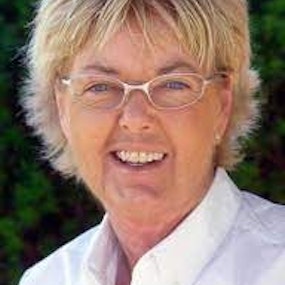
Bradley, Pat
Golf Professional
There has not been a more consistent performer or dedicated individual in Ladies Professional Golf Association history than Pat Bradley. This is a woman who made it on course management, patience and dogged determination, who experienced the highest of highs and the lowest of lows, and then came back to become the 12th woman enshrined in the LPGA Hall of Fame. “Commitment was the key,” Bradley said. “You can have success, failure, setback and defeat, and rise above it.”
During her prime, Bradley competed in 627 tournaments, posting 312 top-10 finishes, with 208 of those in the top five. She became the first woman golfer to surpass the $2 million (1986), $3 million (1990) and $4 million (1991) marks in career earnings and was the first woman to win all four of the modern Major Championships. In 1986, she won the Nabisco Dinah Shore, the LPGA Championship, the du Maurier and finished fifth at the U.S. Women’s Open, three strokes out of the Jane Geddes-Sally Little playoff.
That was the year that defined Bradley’s career. “I have been a very consistent and very good player, but I really believe that in 1986 I was tapped to be a little bit more distinguished than the other players,” Bradley said. “I think somewhere, someone up above picked me to have a year that will go down in golfing history and will make me just a little more special than other people. I honestly wish everyone could experience what I did in that dream-come-true year. I was invincible.”
“You can have success, failure, setback and defeat, and rise above it.”
After every one of he…
Read More
New to FORE the Good of the Game?
Here are some great episodes to start with. Or, check out episodes by topic.














